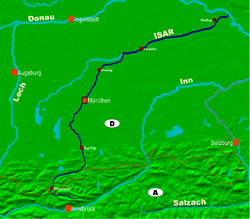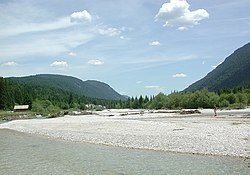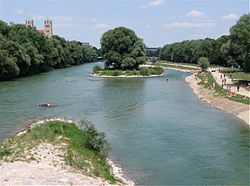Isar
| Isar | |
|---|---|
 The river Isar nearMunich | |
| Location | |
| Countries | |
| Physical characteristics | |
| Source | |
| • location | Eiskarlspitze,Alps,Austria |
| • coordinates | 47°22′29″N11°24′43″E/ 47.37472°N 11.41194°E |
| • elevation | 1,160 m (3,810 ft) |
| Mouth | |
• location | Danube |
• coordinates | 48°48′11″N12°58′35″E/ 48.80306°N 12.97639°E |
| Length | 291.5 km (181.1 mi)[1] |
| Basin size | 8,962 km2(3,460 sq mi)[1] |
| Discharge | |
| • location | mouth |
| • average | 174 m3/s (6,100 cu ft/s) |
| Basin features | |
| Progression | Danube→Black Sea |
TheIsar[ˈiːzaʁ]is ariverinAustriaand inBavaria,Germany.Its source is in theKarwendelmountain range of theAlps.The Isar river enters Germany nearMittenwaldand flows throughBad Tölz,Munich,andLandshutbefore reaching theDanubenearDeggendorf.With 295 km length, it is among the longest rivers in Bavaria. It is Germany's second most important tributary of the Danube.
Etymology[edit]
One theory is that the nameIsarstems from*esor*isin theIndo-European languages,meaning "flowing water" and later turned into a word with a meaning narrowed to frozen water (hence Englishice,German:Eis) inProto-Germanic.The name itself is mentioned for the first time in 763 asIsura.[2]Related names include:
- Eisack/ Isarco (Italy)
- Ésera(Spain)
- Isar(Spanish town, in the province ofBurgos)
- Isauro/ Foglia (Italy)
- Isère(France)
- Isel(Austria)
- IJssel(Netherlands; known to Romans asIsala)
- IJzer/Yser(Belgium)
- Isonzo(Italy)
- Jizera(Czech Republic)
Geography[edit]


The Isar river drains a substantial part of theBavarian Alpsand parts of theKarwendelmountains.
Apart from the larger tributariesLoisachandAmpermany smaller rivers flow into the Isar. Thedrainage basincontains some 9,000 square kilometers (roughly 3,500 square miles). During the winter most of theprecipitationin the Alps turns intosnow.Thesnowmeltcan result in an increased water flow down the Isar rivers during the spring meltdown. It has an averagedischargeat themouthof 174 m3/s.
The official source of the Isar is located in theHinterau valleyeast of the villageScharnitzin theKarwendel mountainsat a height abovesea levelof 1160m. The Lavatschbach is the Isar's longest headstream. A further source for the young Isar is the Birkkarbach, which has its sources in theBirkkarspitzemountain.
The Isar entersUpper Bavariaafter ca. 22 km just north ofScharnitz,the Isar is dammed for the first time betweenMittenwaldandKrün.Some of the Isar waters are channeled via theRißbachinto theWalchensee,the Rißbach flow direction having been reversed. The Isar water flows into the giant downpipes of theWalchensee Hydroelectric Power Station.200 metres lower, the Walchensee Hydroelectric Power Station releases water into theKochelsee.From here it flows into the river Loisach, Isar's second most important tributary.
Not far down the Isar river is a large reservoir calledSylvensteinseewas created between 1954 and 1959 to make more energy generation possible and also to avoid flooding. It is located some 12 km south ofLenggries.It has prevented the flooding ofMunich,for example in 1979, 1999, and most recently in 2005. AtBad Tölzthe Isar leaves theBavarian Alps.Bad Tölz marks the river's transit from its upper to its middle course.
The Isar river flows through a sub-alpine,glacialmorainiclandscape towardsWolfratshausen.Just north of the town theLoisachflows into the Isar. The Isar continues on to and through theMunich gravel plainwhich ends within the city limits of Munich. Further downstream the river passesFreising,then theAmperflows into the Isar, its most important tributary, atMoosburg.This is where the lower course of the Isar river begins.
PassingLandshut,the river makes its way through theTertiary HillsofLower Bavariaall the way into theDanuberiver. The Isar river descends some 848m to flow into the Danube, about five kilometres away fromDeggendorf.[citation needed]
History[edit]

Among Central European habitats, Alpine rivers are ranked among those most substantially altered by humans over the past hundred years. The Isar Rivers are now protected from development.[3]
At the lower Isar betweenMoosburgandPlattlinggoldwas washed from the river's sediments during the 16th and 17th century. However, there was no big economic revenue in this due to the minor amounts of the metal found in the river.[citation needed]Industrializationgave rise to a sociotechnical system were the Isar River was economically exploited through multifunctional use. Over fortyhydropower plantswere built on the Isar to electrify Bavaria.[4]
Following their executions on October 16, 1946, the ashes of the convictedNaziwar criminalsJoachim von Ribbentrop,Hans Frank,Wilhelm Keitel,Alfred Jodl,Alfred Rosenberg,Ernst Kaltenbrunner,Wilhelm Frick,Arthur Seyss-Inquart,Fritz Sauckel,andJulius Streicherwere scattered in the Isar, as were those ofHermann Göringwho had committed suicide the previous night in defiance of his scheduled execution.[citation needed]
In the 1940s and 1950s the federal state of Bavaria financed the construction of major hydroelectric power plants, the Sylvenstein reservoir on the Isar was constructed between 1954 and 1959.[5]
From 2000 till 2011 the Isarplan was implemented to reduce the risk of flooding. The planning and implementation was the responsibility of the Regional Office for Water Management and the city ofMunich.Embankments were removed and the river bed was widened, establishing connections to surrounding flood plains. Riverbed rock ramps were constructed so that fish can move upstream again.[6]
Environmental issues[edit]


Since the 1920s the water of the river Isar has been used for the generation of electricity. This has had far-reaching consequences for the local fauna and flora. To provide the 28 hydroelectric power plants with enough water power the river's water is diverted several times and almost the whole river wascanalized.For example, just north ofMittenwaldall the river's water was diverted to the lakeWalchenseein 1923 for the Walchensee hydroelectric plant. Since 1990 a small portion of the water, 4 cubic meters per second (roughly 1,100 U.S. gallons per second) is allowed to remain in the river Isar to preventdrought.
The construction of theSylvenstein Damand numerous regulations relating to the river, pushed through in the early 19th century, have strongly enhanced its character. The construction of the Sylvenstein dam has prevented the river from overflowing itsbanks.Lately, there have been attempts to bring the Isar river closer back to a natural character. For example, since May 2000 the river is being re-naturalized in the southern part of the river's passage through the city of Munich. The riverbed is being widened, the banks are flattened and small gravel islands are built along with near-natural rock ramps to slow the waterflow.
Besides an improved protection against flooding the Isar river was, thus, brought into an almost natural state and this resulted in an improved quality of the recreational area within the city ofMunich.Themunicipal wastewater treatmenthas also been upgraded along the river. Thewater pollution,however, is still relatively high. Together with other cities and communities along the river Isar, Munich has set a goal to reduce the number of germs. The sewer treatment plants on the upper river are now disinfecting theraw sewagewithultraviolet.
Private environmental initiatives[edit]

To preserve the beauty of the Isar valleyGabriel von Seidlfounded theIsartalvereinin 1902. This first civil initiative from Munich purchased 90 ha of land, and today maintains more than 330 km of hiking trails.
References[edit]
- ^abComplete table of the Bavarian Waterbody Registerby the Bavarian State Office for the Environment (xls, 10.3 MB)
- ^Martin Bitschnau; Hannes Obermair (2009),Tiroler Urkundenbuch. II. Abteilung: Die Urkunden zur Geschichte des Inn-, Eisack- und Pustertals. Band 1: Bis zum Jahr 1140(in German), Universitätsverlag Wagner, pp. 25–27,ISBN978-3-7030-0469-8
- ^Christof Mauch; Thomas Zeller (2008).Rivers in History: Perspectives on Waterways in Europe and North America.University of Pittsburgh Press. p. 212.ISBN9780822973416.
- ^Dieter Schott; Martin Knoll; Uwe Lubken, eds. (2017).Rivers Lost, Rivers Regained: Rethinking City-River Relations.University of Pittsburgh Press.ISBN9780822981596.
- ^Christof Mauch; Thomas Zeller (2008).Rivers in History: Perspectives on Waterways in Europe and North America.University of Pittsburgh Press. p. 212.ISBN9780822973416.
- ^Aletta Bonn; Horst Korn; Jutta Stadler; Nadja Kabisch, eds. (2017).Nature-Based Solutions to Climate Change Adaptation in Urban Areas.Springer International Publishing. p. 265.ISBN9783319560915.
